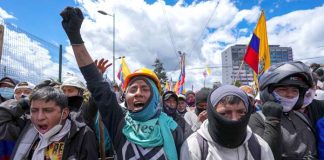Kuala Lumpur’s streets surrounding Dataran Merdeka (Independence Square) turned into a sea of yellow on April 28 as 100,000 gathered for Bersih 3.0, the Bersih movement’s third rally demanding free and fair elections.
This is exactly what the Barisan Nasional (BN) government headed by Najib Tun Razak had been fearing.
On the eve of the protest, a court order banned gathering in the square. Merdeka was made to resemble a massive detention camp, surrounded by barricades and barbed wire.
Earlier that afternoon, hundreds of university students and Occupy Dataran activists who’d occupied the square for two weeks (demanding the abolition of tuition fees and the replacement of a loans scheme with student grants) were forcibly evicted.
The crowd expected that the court order applied only to the square itself and not the surrounding streets. Yet even getting to these streets necessitated breaking through the barricades. Not surprisingly, a section of the crowd did break through in attempt to liberate the square. The police ruthlessly attacked the entire demonstration with tear gas and water cannon.

Almost 500 people were arrested, including media and human rights observers. Over 100 people were hospitalised. There were widespread reports of violence perpetrated against journalists—despite recently touted “reforms” which the state run media say have improved Malaysia’s freedom of the press ranking.
The mass turnout on April 28 despite this kind of state-sponsored intimidation is a sign many Malaysia will no longer tolerate authoritarianism after 52 years of effective one-party rule.
Writing after the protest, Malaysian Socialist Party (PSM) General-Secretary Arul asked: “Why does the Government allow the whole KL city to suffer just in order to protect one rectangle called Dataran Merdeka? The answer is simple. The Government does not want to see any democratic movement to occupy Dataran Merdeka which has its historical importance. Many people spoke about Tahrir square and equate Merdeka Square to that.”
Fear of the Bersih movement has seen the regime crack down on protests through a new Public Assembly Act. This has exposed the government’s repeal of the draconian Internal Security Act, also used to crush dissent, as a political stunt.
There is speculation that Najib may dissolve parliament and call elections as early as June.
But the still fraudulent electoral system will offer little to Bersih activists. The mass mobilisations have been the key so far to forcing change.
As the PSM’s Arul said: “The police and the ruling Government has yet to reform. In spite of new laws, new slogans and new promises, the peoples’ freedom continues to be trampled upon… This is definitely not the last of the rallies for change.”
Already, the BN government’s attempt to blame protesters for the violence on April 28 is unleashing calls for Bersih 4.0.
Mark Goudkamp





